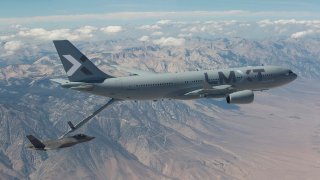How Lockheed Martin's LMXT Can Deter Russia
The capabilities provided by the LMXT "Bridge Tanker" might make Russia pause before threatening its neighbors.
Air Force leaders often speak about the important role that global forward presence plays in U.S. deterrence and power projection in strategic areas. This concept has taken on new urgency as the Chinese military rapidly expands and Russia continues to act aggressively throughout the world.
The U.S. Air Force’s KC-Y tanker program is fundamental to this strategy. Aerial refueling enables and strengthens forward presence. A tanker such as Lockheed Martin’s LMXT could be useful in the Pacific, where vast swaths of ocean create challenges for land-based aircraft.
A new tanker would also contribute to the United States’ forward presence in Europe. Additional tanker support could improve the tactical capabilities available to theater commanders as they work to strengthen U.S. deterrence. While Europe presents a much different strategic and geographical environment than Asia, a “bridge” tanker could still play a vital role. Aerial tankers would increase dwell time and help pilots respond to emerging targets as new intelligence arrives. New networking technologies built into fighters like the F-35 allow pilots to receive new, real-time information in flight.
Fighters could have an even greater impact if they’re able to return to safer air space and refuel with a bridge tanker while remaining in the air. This would allow pilots to quickly and safely refuel before returning for extended missions over hostile territory.
Importantly, the benefits provided by a bridge tanker would support NATO’s efforts to deter Russian aggression in Eastern Europe. Fourth- and fifth-generation NATO air assets would also bolster the alliance’s deterrence posture, especially if they were able to sustain long offensive air missions.
Air power will be essential in any effort to support a strong ground force capable of deterring Russia. Moscow’s willingness to absorb casualties and damage might embolden it to launch a ground invasion against Ukraine. If the United States’ Eastern European allies don’t have powerful air forces with F-35s, Russia might even think that it could move further into Eastern Europe. With this in mind, a networked and upgraded LMXT is essential to credibly threaten Russia with extended stealth air attacks over high-threat areas of Eastern Europe. These capabilities might make Russia pause before invading.
Kris Osborn is the Defense Editor for the National Interest. Osborn previously served at the Pentagon as a Highly Qualified Expert with the Office of the Assistant Secretary of the Army—Acquisition, Logistics & Technology. Osborn has also worked as an anchor and on-air military specialist at national TV networks. He has appeared as a guest military expert on Fox News, MSNBC, The Military Channel, and The History Channel. He also has a Master's Degree in Comparative Literature from Columbia University.
Image: Lockheed Martin.

